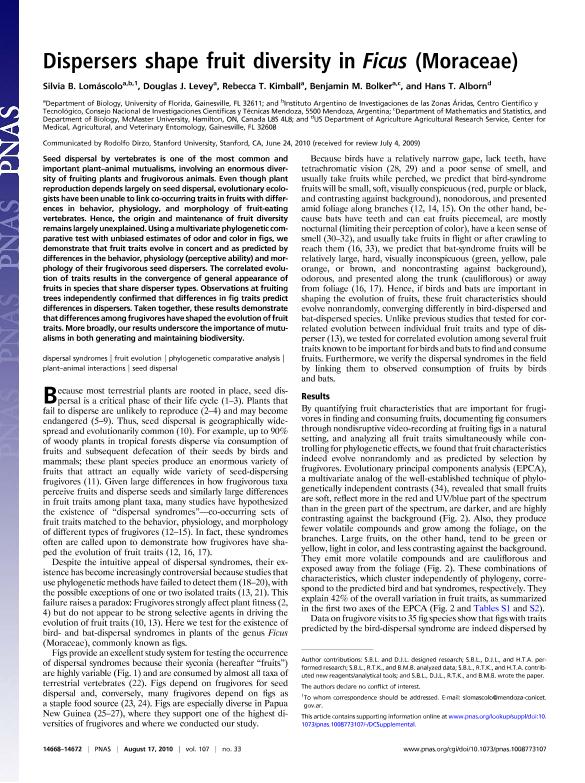Artículo
Dispersers shape fruit diversity in Ficus (Moraceae)
Lomascolo, Silvia Beatriz ; Levey, Douglas J.; Kimball, Rebecca T.; Bolker, Benjamin M.; Alborn, Hans T.
; Levey, Douglas J.; Kimball, Rebecca T.; Bolker, Benjamin M.; Alborn, Hans T.
 ; Levey, Douglas J.; Kimball, Rebecca T.; Bolker, Benjamin M.; Alborn, Hans T.
; Levey, Douglas J.; Kimball, Rebecca T.; Bolker, Benjamin M.; Alborn, Hans T.
Fecha de publicación:
08/2010
Editorial:
National Academy of Sciences
Revista:
Proceedings of the National Academy of Sciences of The United States of America
ISSN:
0027-8424
e-ISSN:
1091-6490
Idioma:
Inglés
Tipo de recurso:
Artículo publicado
Clasificación temática:
Resumen
Seed dispersal by vertebrates is one of the most common and important plant-animal mutualisms, involving an enormous diversity of fruiting plants and frugivorous animals. Even though plant reproduction depends largely on seed dispersal, evolutionary ecologists have been unable to link co-occurring traits in fruits with differences in behavior, physiology, and morphology of fruit-eating vertebrates. Hence, the origin and maintenance of fruit diversity remains largely unexplained.Using amultivariate phylogenetic comparative test with unbiased estimates of odor and color in figs, we demonstrate that fruit traits evolve in concert and as predicted by differences in the behavior, physiology (perceptive ability) and morphology of their frugivorous seed dispersers. The correlated evolution of traits results in the convergence of general appearance of fruits in species that share disperser types. Observations at fruiting trees independently confirmed that differences in fig traits predict differences in dispersers. Taken together, these results demonstrate that differencesamong frugivores have shaped the evolution of fruit traits. More broadly, our results underscore the importance of mutualisms in both generating and maintaining biodiversity.
Archivos asociados
Licencia
Identificadores
Colecciones
Articulos(CCT - NOA SUR)
Articulos de CTRO.CIENTIFICO TECNOL.CONICET - NOA SUR
Articulos de CTRO.CIENTIFICO TECNOL.CONICET - NOA SUR
Articulos(IADIZA)
Articulos de INST. ARG DE INVEST. DE LAS ZONAS ARIDAS
Articulos de INST. ARG DE INVEST. DE LAS ZONAS ARIDAS
Citación
Lomascolo, Silvia Beatriz; Levey, Douglas J.; Kimball, Rebecca T.; Bolker, Benjamin M.; Alborn, Hans T.; Dispersers shape fruit diversity in Ficus (Moraceae); National Academy of Sciences; Proceedings of the National Academy of Sciences of The United States of America; 107; 33; 8-2010; 14668-14672
Compartir
Altmétricas



